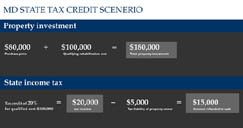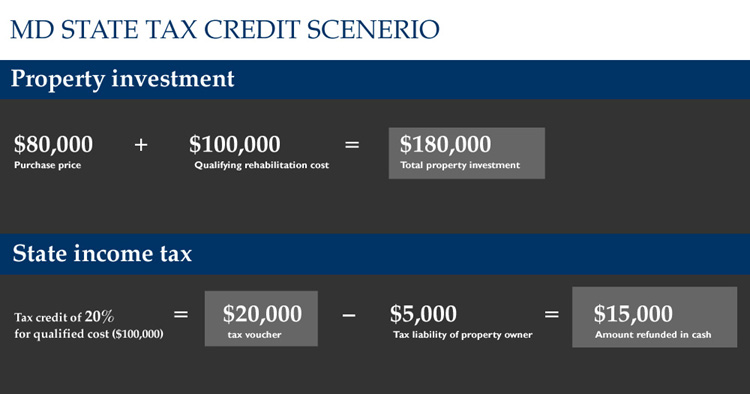State historic tax credits
Local historic tax credits
Federal historic tax credits
|
Maryland State Historical Tax Credit
There are over 50 Historic Districts in Maryland, many located in the City of Baltimore. The State of Maryland Historic Tax Credit offers qualifying resident and non-resident investors as well as home owners a tax credit equal to 20 percent of the money invested in the rehabilitation of a property located within one of these districts (subject to various rules and requirements).
What does this mean to you? Well, let's say that you purchase a house for $80,000 and you invest $100,000 into the rehabilitation of the property. Under the guidelines that govern the Historic Tax Credit program, you would recoup 20 percent of the $100,000 that you invested in the rehabilitation, or $20,000
Thus, if your annual adjusted gross income was $100,000, instead of paying $4,745 in Maryland state tax, you would have received a certificate from the State of Maryland for $20,000 in tax credits and were eligible to use them against your tax liability. Therefore you would have submitted your taxes and instead of sending a check for $4,745, you would have submitted this $20k "voucher." This would have created a surplus of tax credits in the amount of $15,255. You would then be left holding a credit voucher for $15,255 and wondering to yourself, "What do I do now?" Well, Maryland's program is extremely unique in that Governor Glendening signed a bill into law in July 2001 that allows the state to write you a check for the difference. Therefore, when you filed your tax return and voucher between January and April, you effectuated a refund in the amount of $15,255. For real examples of the financial implications of real properties, please click on the three examples located on the home page.
Back to top
Local Tax Credits
To date, only Baltimore City offers a Local Historic Tax Credit (Baltimore County is considering a similar program that, if approved, would go into effect sometime in 2003). The Baltimore City Historic Tax Credit Program is different from State and Federal programs in that it is a credit affecting the property tax of the rehabilitated property rather than a credit against your personal income tax.
For properties located within a Historic District located in the City of Baltimore, the Historic Tax Credit Program allows the City to freeze the value of the property on which it assesses the property tax at the pre-rehabilitation value for 10 years. So, if you purchase property for $80,000 and spend $100,000 on the rehabilitation, the value on which the City assesses the property tax would be the $180,000 post-rehabilitation value, resulting in approximately $3,900 in property tax. However, if you purchase property and qualify for the City Historic Tax Credit Program, the City will, for 10 years, freeze the value on which it assesses your taxes at the $80,000 pre-rehabilitation value, which equates to an annual savings of approximately $2,020 in property tax or $20,200 over 10 years, $2,020 annually, and $168 monthly. This credit stays in effect for 10 years regardless of whether or how many times the house is subsequently sold.
How does this translate into dollars and what does it mean to you? Well, for the homeowner, it means you may be able to afford more than $100,000 in rehabilitation because you will pay taxes on a property in which the tax is based on a value of $80,000 (rather than $100,000) thereby reducing your monthly escrow payment.
For the investor, there are other benefits. If an investor is interested in renting the property, it minimizes monthly overhead as the monthly escrow payments will be calculated on a property assessed at $80,000. If want to rehabilitate the property and sell it, the impact of this credit is substantial Again, let's use the example above to demonstrate the benefits of the credit in a resale:
You have invested $180,000 into this property and, let's say that the property is located in an area where similar houses are selling, on average, for approximately $250,000. The monthly payment on a $250,000 home, mortgaged for 30 years with a 7 percent interest rate is $1,663. If this property does not benefit from the City Historic Tax Credit, the new purchaser will pay taxes of $5875 annually which, with the monthly escrow payment, makes their payments $2,153. However, by using the credit, the seller of this property will attract more potential buyers because the monthly payment, including the escrow payment, will be $1,819, a difference of $334, or over $4,000 a year. Besides the obvious advantages, there are two selling points that can be made.
1. In a competitive market if your home is situated near other homes that is identical in features, your property will have an advantage because of the tax credits over the other properties.
2. It increases the target market of potential buyers from those who can afford $250,000 or more, to those who can afford up to $200,000. Given the example/terms above, the difference in monthly payments, including the escrowed tax is the difference, between a mortgage on a $250,000 home and that of a $200,000 home. The number of potential buyers just increased.
Back to top
Federal Tax Credits
Like the State Tax Credit program, the Federal government has a program that offers a credit against your passive income and income from real estate equal to 20 percent of your total rehabilitation expenditures. This credit, however, has some rules that limit its use. As experienced professionals in this area of tax credits, we will be able to consult you as to the best way to use this credit.
Back to top
| Womens Tennessee Titans กฏ47 Brand Navy Blue Pep Rally Pants,wholesale jerseys facebook,wholesale nfl car flag w,Women's Dallas Cowboys Nike Navy Performance Tank Top.San Diego Chargers Preschool Heico Hoodie - Ash,San Francisco 49ers Team Plastic Hitch Cover Blake Bortles Jersey Sale.Mens Oakland Raiders Bo Jackson Nike White Retired Player Game Jersey,Men's Carolina Panthers Nike Black Facility T-Shirt http://www.jacksonvillejaguarsjerseys.com.Denver Broncos Woven Checkered Tie - Navy Blue/Orange,Tennessee Titans Moccasin Slippers - Tan,Mens San Diego Chargers '47 Brand Navy Blue/White Classic Freshman Franchise Fitted Hat Bengals jerseys for Cheap.Detroit Lions 8" Plush Duck,Mens Seattle Seahawks Gray Front and Sleeve Full Zip Jacket,Oakland Raiders Passing Game II Hoodie Sweatshirt - Black Blake Bortles Jersey Sale.Women's New York Giants Junk Food Cream All American Raglan Three-Quarter Length Sleeve T-Shirt,Men's San Diego Chargers Nike Heather Gray Legend Logo Long Sleeve Performance T-Shirt Cheap Jacksonville Jaguars Blake Bortles Jersey.New Era Baltimore Ravens Men's Time Super Bowl Champions 39THIRTY Structured Flex Hat,Men's Carolina Panthers Majestic Charcoal Big & Tall Kick Return Pullover Hoodie,Men's Indianapolis Colts G-III Sports by Carl Banks Royal Winning Streak Swim Trunks.Mens Jacksonville Jaguars Blake Bortles Nike Teal Alternate Game Jersey,Men's Kansas City Chiefs Pro Line Charcoal Taylor Tri-Blend T-Shirt
MD STATE TAX CREDIT SCENARIO
 
roll-over or click to view larger image
LOCAL TAX CREDIT
 
roll-over or click to view larger image
|




